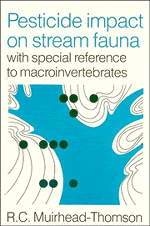Book contents
- Frontmatter
- Contents
- Preface and Acknowledgements
- PART I INTRODUCTION AND ORIGIN OF PESTICIDES IN RUNNING WATERS
- PART II THE ROLE OF LABORATORY AND EXPERIMENTAL METHODS IN EVALUATION
- THREE Laboratory evaluation techniques
- FOUR Artificial community streams and channels in situ
- FIVE Invertebrate reaction to pesticides under laboratory and experimental conditions
- PART III EVALUATION IN PEST CONTROL PROJECTS
- Summary and assessment
- References
- Index
THREE - Laboratory evaluation techniques
Published online by Cambridge University Press: 05 November 2011
- Frontmatter
- Contents
- Preface and Acknowledgements
- PART I INTRODUCTION AND ORIGIN OF PESTICIDES IN RUNNING WATERS
- PART II THE ROLE OF LABORATORY AND EXPERIMENTAL METHODS IN EVALUATION
- THREE Laboratory evaluation techniques
- FOUR Artificial community streams and channels in situ
- FIVE Invertebrate reaction to pesticides under laboratory and experimental conditions
- PART III EVALUATION IN PEST CONTROL PROJECTS
- Summary and assessment
- References
- Index
Summary
INTRODUCTION
In comparing the reactions of different aquatic organisms to toxic chemicals (whether they are inorganic in the form of heavy metals, ammonia, cyanides etc. or more complex organic pesticides), it has long been the aim of the toxicologists involved to attain some standardisation or uniformity in the experimental techniques they devise. This approach to unification of methods has been particularly marked in the case of freshwater fish, for which group there are now standard methods acceptable in most countries.
These standard methods lay down guidelines on the exact conditions of the tests vis-à-vis water quality, temperature, number and size of test organisms, duration of exposure to the chemical dilution and, finally, the criteria to be adopted when measuring the effect in terms of immobility or mortality.
The need for the same degree of uniformity in testing other forms of freshwater life, invertebrates in particular, though slow to develop has gained increasing momentum in the last 10 years or so. Much of this incentive has come from the US Environmental Protection Agency (EPA) which now plays an international role in the screening and clearance of all pesticides and other toxic chemicals likely to have a harmful effect on the environment. One of the first fruits of this increased interest in aquatic invertebrates appeared in 1972 in the form of an exhaustive summary – compiled by the EPA – of all published information on their reactions in the laboratory to a wide range of pesticides, mainly insecticides, and herbicides (NTIS, 1972).
- Type
- Chapter
- Information
- Pesticide Impact on Stream FaunaWith Special Reference to Macroinvertebrates, pp. 23 - 51Publisher: Cambridge University PressPrint publication year: 1987



